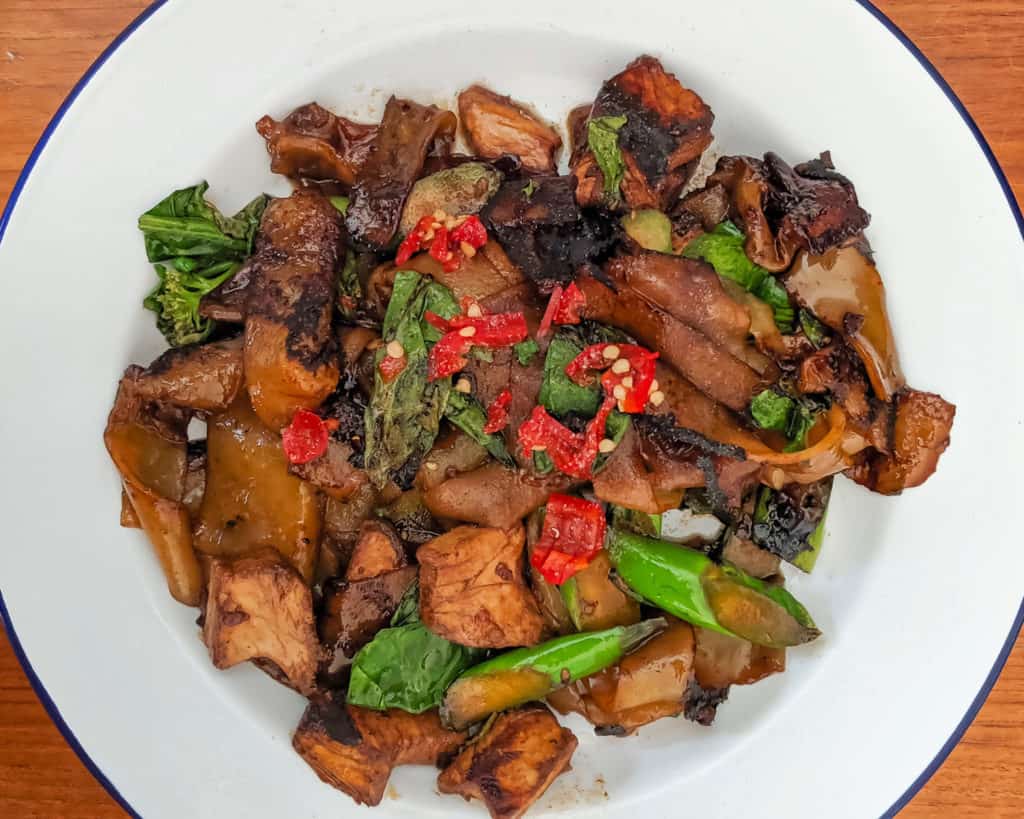Pad see ew (the last word is pronounced as if two syllables, like ee-yew) literally means "stir fry with soy sauce". With the right ingredients to hand, this noodle dish is bewitchingly straightforward to prepare. That such a time honoured restaurant favourite could come together so quickly and easily feels almost fraudulent.
There are a few tricks to achieve a top notch pad see ew. The first is high heat. Keeping in mind that commercial wok burners fire upwards of 100,000 BTU and the average home range is 7,000 BTU per burner, it's paramount you fire your wok on the highest heat possible. No exception.
Second, timing is important but perhaps contradictory to how you might think. During cooking, the noodles should be left undisturbed for a minute or two on each side to burn. Yes, burn. The caramelisation of sugars and charring is what gives pad see ew its signature flavour and texture.
Finally, you will never achieve restaurant level results unless you use fresh rice noodles (hor fun or sen yai). These are available at East Asian grocers, though unfortunately they are typically chilled. If this is the case, steam the noodles for a few minutes over medium heat so they are pliable and can be peeled apart without breaking up. If you live in or around London, I admonish you to make a trip to Lo's Noodle Factory in Chinatown, where you can buy straight-off-the-conveyor fresh rice noodles for a quid. If you are unable to purchase fresh rice noodles, I recommend making them fresh.
Pad See Ew ผัดซีอิ๊ว
Stir fried fresh rice noodles with soy sauce
- 1 tablespoon sweet dark soy (or kecap manis)
- 1 tablespoon thin soy sauce
- 1 teaspoon seasoning sauce
- ½ teaspoon Thai dark soy sauce
- ½ teaspoon white sugar
- 1.5 tablespoons vegetable oil
- 1 tablespoon minced garlic
- 50-60 grams kai lan, stems cut thinly on diagonal in 1 inch pieces
- ½-3/4 cup cubed tofu or mock meat
- 250 grams fresh rice noodles, separated
- Optional but recommended condiments for serving: chilli vinegar, white pepper, white sugar, roasted chilli powder, more vegan fish sauce or soy sauce.
- Mix all sauces and sugar together in a small bowl.
- Heat wok to highest heat possible. Add oil. When it smokes tip in the garlic, which will colour quickly. Once it starts to turn golden add kai lan and tofu. Don't be put off by the garlic burning a little (this style of cooking goes against European standards that insist garlic must never burn). Stir fry for 30 seconds.
- Add noodles and sauce, scraping the bottom to make sure any settled sugar doesn't go amiss. Toss the sauce through the noodles and then leave the whole lot for about a minute. It may seem like there's too much liquid to start but it will get soaked up by the noodles and cook down.
- Flip the noodles (it doesn't need to be an even flip – just get some of them turned over). Cook another minute or two undisturbed. It will take everything in you to not agitate them because they will char a little. That's the point. The sugars caramelise and burn a little on the noodles on each side.
- Serve with some white pepper on top and alongside condiments. I usually add some extra vegan fish sauce or soy sauce and loads of chilli vinegar. Sometimes sugar.
- Author: Kip Dorrell
- Serves: 1
- Cuisine: Thai
Now for a brief linguistic aside
The Royal Thai General System of Transcription (RTGS) is the official system Romanising Thai language. That is, converting non latin characters into their Latin alphabet equivalents. There are many other systems of romanisation and little agreement upon which is best to use.
If you have noticed inconsistent spellings of dishes on Thai menus, the reason isn't that restaurateurs can't spell. Instead the confusion is grounded in the lack of agreement on which system to use and whether to focus on phonemes (the sounds in words) or graphemes (the way we spell those sounds). This is why you may see the name of this dish spelled pad see ew, phad si iew, pat sii uuu, and many more. The official RTGS transcription is phat si io, but the most commonly accepted spelling is pad see ew.
